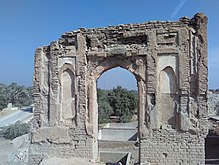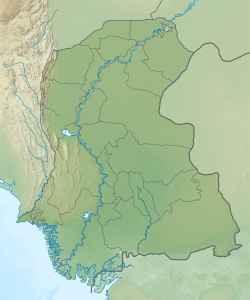Aror
 | |
| Location | Sukkur District, Sindh, Pakistan |
|---|---|
| Coordinates | 27°39′00″N 68°59′00″E / 27.65°N 68.9833°E |
| Type | Settlement |
| History | |
| Abandoned | 9th century AD |
Aror (Sindhi: اروهڙ) or Alor or Arorkot (Sindhi: اروهڙ ڪوٽ) is the medieval name of the city of Rohri (in Sindh, modern Pakistan).[1][2] Aror once served as the capital of Sindh.[3][4][5]
History
As Roruka, capital of the
Rohri City, previously Rori Shankar, was built by Raja Dhaj in 5th BCE and was ruled under the Ror Dynasty (450 BC to 489 AD) was served as a busy port along the Indus and was a major trading centre for Kings of Sauvira or Roruka.[13]
Aror is the ancestral town of the Arora Community.[14][15][4][16][17] In 711, Aror was captured by the army of Umayyad general Muhammad ibn al-Qasim.[18]
In 962 it was hit by a massive earthquake that changed the course of the Indus River and ruined the town's mud brick building,[19] thereby setting into play the city's decline, and eventual re-settlement at Rohri,[20] along the modern-day shores of the Indus.[21]
Ruins
Most of Aror's ruins have been lost, though some arches of a mosque built shortly after the 8th century Arab invasion remain standing.[21] The Kalka Cave Temple, a Hindu temple dedicated to Kalkaan Devi, still exists near the ruins, and is still used.[21] The Chattan Shah ji Takri shrine is built atop a high rock outside the city, and is traditionally believed to be a companion of Ali, cousin of Muhammad.[21]
See also
- Aror University of Art, Architecture, Design and Heritages
- Rohri
- Muhammad bin Qasimath-Thaqafī
Ottomano C. and Biagi P. 1997 - Palaeopedological observations and radiocarbon dating of an archaeological secyion at Aror (Sindh-Pakistan). Ancient Sindh, 4: 73-80
References
- ISBN 9788173040962. Retrieved 8 October 2014.
The Arora or Rora is a community of traders of the south-western part of the Punjab. Their origin according to the Bhavishya Purana, can be traced back to the time of Parshuram, who in anger started killing the Kshatriyas. In this process, Parshuram met a Kshatriya who refused to oppose the Brahmans, and winning Parshuram's respect, was asked to go to Sindh to setde there. Later, the place came to be known as Arutkot or Arorkot. His progeny are called Aroras.
- ^ "The News on Sunday (TNS) » Weekly Magazine - The News International". www.thenews.com.pk. Retrieved 1 August 2023.
More than a thousand years ago Arore (also known as Alore) was the capital of Sindh, and the boundaries of this Hindu kingdom extended far and wide.
- ^ Commissioner, India Census (1912). Census of India, 1911 ... Printed at the Government central Press. p. 445.
The Arora or Rora is evidently connected with Arorkot near Rori (Sukkur), the ancient capital of Sindh .
- ^ ISBN 9780195656480. Retrieved 8 October 2014.
The Aroras were also said to be the Khatris of Arorkot, or Aror, the ancient capital of Sindh.
- ^ Handbook of the Punjab, Western Rajputana, Kashmir, and Upper Sindh. John Murray. 1883. p. 293. Retrieved 8 October 2014.
Aror.--While at Rorhi, a visit may be paid to the very ancient town of Aor, which is only 5 m. distant to the E. This was the capital of the Hindu Rajas of Sindh and was taken from them by the Muslims, under Muhammad Kasim, about 711 A.D. At that time the Indus washed the city of Battle of Aror, but it was diverted from it by an earthquake about 962 A.D., at which the river entered its present channel.
- ^ Derryl N. MacLean (1989), Religion and Society in Arab Sind, p.51,136
- ^ Hughes, Albert William (1876). A Gazetteer of the Province of Sind. G. Bell and Sons. p. 677. Retrieved 19 December 2017.
aror .
- ^ "The Mahabharata, Book 8: Karna Parva: Section 44". Internet Sacred Text Archive. Retrieved 13 September 2015.
- ISBN 978-81-7022-373-3.people left Sind and settled in the Punjāb cities, situated on the banks of the rivers Sind, Jhelum, Cenāb and Rāvī.
When Muhammad-bin-Qāsim plundered the place Arora in 712 and defeated Rājā Dāhar, who belonged to the Arorā dynasty, the Arorā
- ISBN 9004085513.
- ISBN 979-8-88975-967-6.
- ^ Errorless 16 Year-wise MPPSC General Studies Prelims Solved Paper 1 (2003 - 21) 2nd Edition. Disha Publications. 2021. p. 10.
- ^ "History of Sukkur- Begum Nusrat Bhutto University Sukkur". Retrieved 19 March 2024.
- ISBN 978-0-19-977169-1.
- ISBN 978-81-7022-373-3.people left Sind and settled in the Punjāb cities, situated on the banks of the rivers Sind, Jhelum, Cenāb and Rāvī.
When Muhammad-bin-Qāsim plundered the place Arora in 712 and defeated Rājā Dāhar, who belonged to the Arorā dynasty, the Arorā
- ^ Thakur, U. T. (1959). Sindhi Culture. University of Bombay. p. 58.
This Arorkot is Arore or Alore and the Aroras are called after the name of the ancient capital Arore.
- ISBN 978-0-7069-8368-5.
- ^ History of the Punjab, Volume 1 by Fauja Singh, Published by the Department of Punjab Historical Studies, Punjabi University, 1977
- Rose, H. A (1911). A Glossary of The Tribes & Castes of The Punjab & North West Frontier Province. Vol. II. Lahore: Samuel T. Weston. p. 17. Retrieved 24 October 2011.
- ISBN 1403457182. Retrieved 19 December 2017.
- ^ a b c d "Where the city of Aror once stood in glory". Dawn. Retrieved 19 December 2017.


